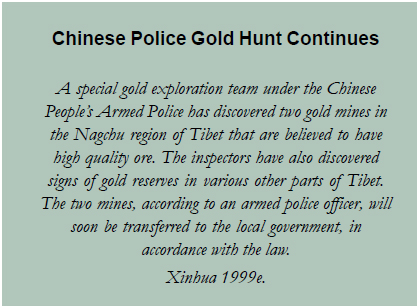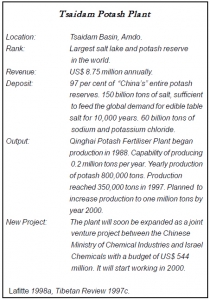A Rundown Of Reserves Due To Mining
Chromite
Chromite reserves in Tibet are the largest in today’s political China and the reserves in ‘TAR’ alone make up 40 per cent of what China claims as its national reserve. Chromite is the main material used to produce special steel and stainless steel. The now-exhausted Shar Lung mine in Nagchu region produced more than 60,000 tons of chromite ore between 1978 and 1979. From 1980 to 1985 the mine produced 300,000 tons of the ore, which had a value of around US$ 11 million (Research and Analysis Centre 1991).
Norbusa Chromite Mine in Lhoka is the largest of its kind in Tibet. The mine’s potential value is predicted at about US$ 375-500 million (Tibetan Review 1998a) and contains more than 57 per cent of chromite oxide, rated as one of the top chromite deposits in the world (DIIR 1996b). In the 1980s, Norbusa mine produced a revenue of more than US$ 1.5 million (China’s Tibet 1996). In 1992, the mine represented 50 per cent of the total industrial output of all industrial enterprises in ‘TAR’, and the total extraction of chromite between 1979 and 1989 was worth US$ 34 million. The construction of the mine was a key state project in the Eighth Five Year Plan (1991-95), with a total investment of US$ 10.7 million (DIIR 1996b). The production of 190,000 tons of chromite in those five years has paid more than US$ 3.25 million in tax to the ‘TAR’ (Waiser 1998).
With more profit in producing ferrochrome than metallurgical chromite, and with the increasing output of chromite in Tibet, the authorities produced their first batch of ferrochrome alloy in 1990. This demand is mainly driven by the stainless steel industry and this inexorable trend looks set to continue. By the end of last century the annual production of ferrochrome alloy is expected to reach 5,000 tons (Xinhua 1998a).
Copper
The ‘TAR’ has potential copper reserves of 13 million tons with proven reserves of 8.85 million tons. The region contains 14.4 per cent of “China’s” copper reserves, which make up the third largest reserves and the largest porphyry copper belt in “China”. Yulong Copper Mine in Jomda County, Chamdo, ‘TAR’, is among the largest mines of its kind in the world with an area of 1,870 sq km. The mine has a reserve of 7.14 million tons (Xinhua 1997a) and “with further investment and exploration around the region, this copper belt has tremendous significance in reducing China’s foreign exchange expenditure and increasing Tibet’s national income”, states the internal document “The Specialist Plan for the TAR” (TIN 1997e).
Despite China’s remarkable growth of copper production from 386,600 tons in 1980 to more than 1.1 million tons in 1997, the country was unable to meet its demand of 1.3 million tons in 1997. Therefore, China has opened up seven projects with big investments to curtail its copper imports. Two of the projects are located in Tibet, namely the Yulong Copper Mine in Chamdo and the Sashithang Copper Mine in Tsolho, Amdo. Both these mines are included in the Ninth Five Year Plan (1996-2000) with an investment of US$ 1.62 million and US$ 27.5 million respectively. The Sashithang mine has proven copper reserves of 230,000 tons. The operation of these mines in Tibet will help China ease its copper shortage in the market (TIN 1997d).
Other copper mines in Tibet, such as the one in Mongyon Hui County, Tsochang, Amdo also have rich reserves and good quality copper. Extraction at Mongyon Copper Mine started in 1958, exporting of copper started in 1983, and nowadays it is the chief source of income for people living in that area. Copper reserves in Machen County in Golok are considered to be 545,000 tons and in Norbusa Copper Mine at Chusum, Lhoka, the Chinese authorities have an investment of US$ 6.81 million (Research and Analysis Centre 1991).
Gold
Tibet has abundant gold reserves, particularly in Amdo as indicated by the following discoveries. On 22 July 1983, three farmers found 3.5 kg of natural gold rock in Yaradu, Wulan County (Research and Analysis Centre 1991) and in another incident a lump of natural gold weighing 6.57 kg was found in Amdo in 1996 (Tibetan Review 1997a). Hungjintai Gold Mine in Matoe, Golok, located at an altitude of 4,670 metres is the highest gold mine in the world. The production of gold in Amdo region in 1991 was over 200 kg (DIIR 1992) and in 1995 it reached 827.5 kg (TIN 1999a). Kandze, Kham, now incorporated into Sichuan Province, is a land strewn with gold reserves. Though much of the mining is kept secret, in 1986 China earned US$ 1.5 million from the sale of gold mined in Kandze (Research and Analysis Centre 1991). Tawo County, Kandze, alone had gold deposits of 22 tons, according to Radio Lhasa on 23 September, 1985. In Pongtsa-rawa, Dechen County in Kham, gold is collected from the river.
In the ‘TAR’, the Nagchu area has reserves of 10.1 tonnes of alluvial gold. Bengna Zhuangbu Gold Mine in Shentsa County, Nagchu, which started production in 1997, is the largest gold mine in the region. The mine is one of the highly publicised “62 Development Projects” in the ‘TAR’. It is estimated that the mine will produce an annual average of 450,000 cubic metres of ore, and 386.6 kg of gold, with an annual net profit of US$ 1.56 million (Zhongguo Xinwen She 1997).
Laoran Mountain, Maodou, Markham in Kham, produces more than 100 kg of gold annually and due to gold content at a shallow depth the mine is expected to form large-scale gold deposits in the near future. In the ‘TAR’, an aggregate 14.225 tons of deposits was discovered in six gold mining zones in 1993. In 1994, the production of gold in the region was 13.527 kg, which was an increase of more than 360 per cent from 1993. In 1995, there were 148 gold mines zones in the ‘TAR’ (Tibet People’s Broadcasting Station 1995) with substantial gold reserves at 100 sites (Namgyal 1995).
Oil and Gas
According to many geologists Tibet is perhaps “the last and the largest oil belt on the continents”. The region has favourable geology for oil formations: The stratum are of the Mesozoic and Cenozoic periods and similar to the oilfields in the Persian Gulf and the Karakorum in Central Asia (Xinhua 1997c). Tsaidam Basin in Amdo — an area of 220,000 sq.kms, almost the size of Britain — and Chang Thang are the two major oil deposit zones in Tibet.
Tsaidam Basin has oil reserves of 42 billion tons and natural gas reserves of 1,500 billion cubic metres in 22 deposits (Tibet Daily 1998b). With China currently consuming 22 billion cubic metres of gas a year, Tsaidam’s estimated reserves of 1,500 billion cubic metres would supply the Mainland’s current need for up to seven years. Gas has been identified as the most practical and transferrable nonpolluting energy to serve China’s southern and eastern coastal boom cities in future and Tibet’s Tsaidam gas fields are earmarked as the primary supplier. A pipeline is due to take Tsaidam gas to Lanzhou in 2002 — the first phase in a mammoth network to finally in corporate Xinjiang, Kazakh and Siberian gas fields. Since Chinese exploration started in 1954, more than 23.5 million tons of oil has been extractedfrom Tsaidam.
After years of oil exploration in Chang Thang, the first deep oil deposit — with 200 million tons — has been found in Lhunpula Basin. The basin is also stated to have a proven deposit of 1.5 million tons of oil (Xinhua 1997c). In 1999 another discovery in the same region found higher oil reserves of three million tons. According to several Chinese scientists, the total reserve in the basin is predicted to contain up to 10 million tons of oil. China National Star Petroleum Corporation plans to build at least one field with an annual capacity of 50,000 metric tons in the basin (South China Morning Post 1999b).
The basin is situated at an altitude of 4,700 metres above sea level and it is located 300 km northwest of Nagchu in Northern Tibet. An excellent quality oil field of 6 sq km was found in the region, with four prospective first grade oil gas zones, and one second prospective grade of oil zone. Excellent conditions for the formation of oil were determined in the region with three potential gas zones and 22 structured zones. The achievement of the prospecting team in the region was considered as a major breakthrough in oil discoveries. Many Chinese scientists predict that the region will become the major oil reserve base in the 21st century (Xinhua 1997c).
Uranium
Tibet has the world’s largest deposits of uranium. By 1990 more than 200 uranium deposits were discovered in Tibet, according to a China Daily report on 28 May 1990. The actual size of the uranium resources on the plateau is closely guarded by the Chinese government, but the location of the resources are indicated by the presence of the former Ninth Academy, which was involved in nuclear weapons development, around the eastern mountainous shores of Lake Kokonor (DIIR 1992). The largest uranium mine is in Thewo, Kanlho (Gannan) Tibetan Autonomous Prefecture, Gansu Province (Chutter 1998). Known mines of uranium include Tsaidam Basin and Thewo in Amdo and Yamdrok Tso and Damshung, near Lhasa (Dekhang 1998).
Apart from mining uranium in Tibet, the Chinese also extract strontium which is used for nuclear missile cladding (Chutter 1998). A deposit of over 18 million tons of radioacitve strontium was discovered at Tsaidam in 1994 according to Xinhua. Official said the deposit was near the surface and easy to extract (Reuters 27 January 1994). The concentration of plutonium in the deep salt lakes of Tsaidam Basin is another major discovery in Tibet; however its extraction is unknown. The salt lakes also contain well known, large and accessible quantities of lithium which has many industrial applications such as its use as a raw material for nuclear fusion weapons (Slesser 1998). The lithium deposits in Tsonub, Amdo and the ‘TAR’ represent nearly all of “China’s” known lithium resources (Beijing Review 1998a) and the total lithium deposits in Tibet are considered the largest in the world (Waiser 1998).
Cesium
A quarter of the world’s cesium deposits (27.6 per cent ) are discovered in Tibet (TIN 1991) and, according to an announcement made by the Chinese Academy of Geological Science, the deposit discovered in ‘TAR’ is estimated to have a value of as high as US$ 6.48 billion. This rare metal is mainly used in military and hi-tech applications, e.g. atomic clocks and high-energy solid fuel. (Keji Ribao 1999).
Source: Tibet 2000 Enviornment and Development Issues, DIIR




comment 0